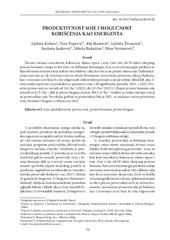Приказ основних података о документу
Produktivnost soje i mogućnost korišćenja kao energenta
Productivity of soybean and the possibility of using it as energy
| dc.creator | Kolarić, Ljubiša | |
| dc.creator | Popović, Vera | |
| dc.creator | Ikanović, Jela | |
| dc.creator | Živanović, Ljubiša | |
| dc.creator | Janković, Snežana | |
| dc.creator | Rakašćan, Nikola | |
| dc.creator | Stevanović, Petar | |
| dc.date.accessioned | 2023-11-26T17:43:36Z | |
| dc.date.available | 2023-11-26T17:43:36Z | |
| dc.date.issued | 2023 | |
| dc.identifier.issn | 0354-5881 | |
| dc.identifier.uri | http://fiver.ifvcns.rs/handle/123456789/4032 | |
| dc.description.abstract | Žetveni ostataci suncokreta, kukuruza, uljane repice i soje, čine više od 50 odsto ukupnogprinosa biomase i mogu se koristiti i za dobijanje bioenergije. Кao izvoru bioenergije prednost sedaje žetvenim ostacima koji sadrže više celuloze i ulja, kao što je na primer slama soje. Oplemenji-vanje soje ima za cilj stvaranje sorti sa većom biomasom i povećanim prinosom ulja po hektaru,kao i stvaranje sorti koje bi više odgovarale industrijskoj preradi za proizvodnju tehničkih ulja. Uovoj studiji ispitivani su produktivni parametri soje u dvogodišnjem periodu, 2021. i 2022. Pro-sečni prinosi soje su varirali od 2,8 t ha-1 (2022), do 2,9 t ha-1 (2021). Ukupni prinosi biomase sojeiznosili su 4,75 t ha-1, dok je prinos biogasa iznosio 384,5 m3 ha-1. Godina je imala značajan uticajna proizvodnju soje. Povoljnija godina za proizvodnju bila je 2021. sa značajno većim prinosimazrna, biomase i biogasa u odnosu na 2022. | sr |
| dc.description.abstract | Harvest residues of sunflower, maize, oilseed rape and soybeans make up more than 50% of the total biomass yield and can also be used to obtain bioenergy. As a source of bioenergy, preference is given to harvesting residues that contain more cellulose and oil, such as soybean straw. Soybean breeding aims to create varieties with higher biomass and increased oil yield per hectare, as well as to create varieties that would be more suitable for industrial processing for the production of technical oils. In this study, the productive parameters of soybeans were investigated in two years, 2021 and 2022. The average yields of soybeans varied from 2.8 t ha-1 (2022) to 2.9 t ha-1 (2022). The total soybean biomass yield was 4.8 t ha-1, while the biogas yield was 384.5 m3 ha-1. The year had a significant impact on soybean production. The more favourable year for production was 2021, with significantly higher yields of grain, biomass and biogas, compared to 2022. | sr |
| dc.language.iso | sr | sr |
| dc.publisher | Beograd : Društvo selekcionera i semenara Republike Srbije | sr |
| dc.relation | info:eu-repo/grantAgreement/MESTD/inst-2020/200032/RS// | sr |
| dc.relation | info:eu-repo/grantAgreement/MESTD/inst-2020/200116/RS// | sr |
| dc.relation | info:eu-repo/grantAgreement/MESTD/inst-2020/200045/RS// | sr |
| dc.rights | openAccess | sr |
| dc.rights.uri | https://creativecommons.org/licenses/by/4.0/ | |
| dc.source | Selekcija i semenarstvo | sr |
| dc.subject | soja | sr |
| dc.subject | produktivnost | sr |
| dc.subject | prinos zrna | sr |
| dc.subject | prinos biomase | sr |
| dc.subject | prinos biogasa | sr |
| dc.subject | biomass yield | sr |
| dc.subject | biogas yield | sr |
| dc.subject | grain yield | sr |
| dc.subject | productivity | sr |
| dc.subject | soybean | sr |
| dc.title | Produktivnost soje i mogućnost korišćenja kao energenta | sr |
| dc.title | Productivity of soybean and the possibility of using it as energy | sr |
| dc.type | article | sr |
| dc.rights.license | BY | sr |
| dc.citation.epage | 59 | |
| dc.citation.issue | 1 | |
| dc.citation.rank | M51~ | |
| dc.citation.spage | 51 | |
| dc.citation.volume | 29 | |
| dc.identifier.doi | 10.5937/SelSem2301051K | |
| dc.identifier.fulltext | http://fiver.ifvcns.rs/bitstream/id/9706/bitstream_9706.pdf | |
| dc.type.version | publishedVersion | sr |


